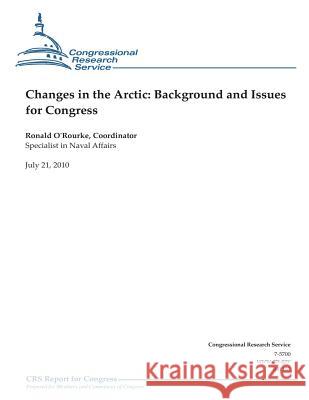Changes in the Arctic: Background and Issues for Congress » książka
Changes in the Arctic: Background and Issues for Congress
ISBN-13: 9781475275841 / Angielski / Miękka / 2012 / 68 str.
The diminishment of Arctic sea ice has led to increased human activities in the Arctic, and has heightened concerns about the region's future. The United States, by virtue of Alaska, is an Arctic country and has substantial interests in the region. On January 12, 2009, the George W. Bush Administration released a presidential directive, called National Security Presidential Directive 66/Homeland Security Presidential Directive 25 (NSPD 66/HSPD 25), establishing a new U.S. policy for the Arctic region. Record low extent of Arctic sea ice in 2007 focused scientific and policy attention on its linkage to global climate change, and to the implications of projected ice-free seasons in the Arctic within decades. The Arctic has been projected by several scientists to be perennially ice-free in the late summer by the late 2030s. The five Arctic coastal states-the United States, Canada, Russia, Norway, and Denmark (of which Greenland is a territory)-are in the process of preparing Arctic territorial claims for submission to the Commission on the Limits of the Continental Shelf. The Russian claim to the enormous underwater Lomonosov Ridge, if accepted, would reportedly grant Russia nearly one half of the Arctic area. There are also four other unresolved Arctic territorial disputes. The diminishment of Arctic ice could lead in the coming years to increased commercial shipping on two trans-Arctic sea routes. Current international guidelines for ships operating in Arctic waters are being updated, with a targeted completion date of 2010. Changes to the Arctic brought about by warming temperatures will likely allow more exploration for oil, gas, and minerals. Warming that causes permafrost to melt could pose challenges to onshore exploration activities. Increased oil and gas exploration and tourism (cruise ships) in the Arctic increase the risk of pollution in the region. Cleaning up oil spills in ice-covered waters will be more difficult than in other areas, primarily because effective strategies have yet to be developed. Large commercial fisheries exist in the Arctic. The United States is currently meeting with other countries regarding the management of Arctic fish stocks. Changes in the Arctic could affect threatened and endangered species. Under the Endangered Species Act, the polar bear was listed as threatened on May 15, 2008. Arctic climate change is also expected to affect the economies, subsistence, health, population, societies, and cultures of Arctic indigenous peoples. Two of the Coast Guard's three polar icebreakers-Polar Star and Polar Sea-have exceeded their intended 30-year service lives. The Coast Guard since 2008 has been studying how many polar icebreakers, with what capabilities, should be procured as replacements for Polar Star and Polar Sea. The possibility of increased sea traffic through Arctic waters also raises an issue concerning Arctic search and rescue capabilities. The Arctic has increasingly become a subject of discussion among political leaders of the nations in the region. Although there is significant international cooperation on Arctic issues, the Arctic is also increasingly being viewed by some observers as a potential emerging security issue. In varying degrees, the Arctic coastal states have indicated a willingness to establish and maintain a military presence in the high north. U.S. military forces, particularly the Navy and Coast Guard, have begun to pay more attention to the region.
Zawartość książki może nie spełniać oczekiwań – reklamacje nie obejmują treści, która mogła nie być redakcyjnie ani merytorycznie opracowana.











